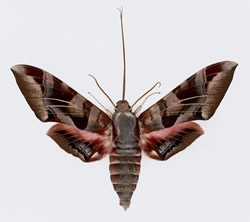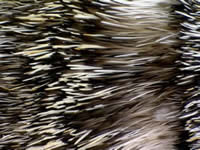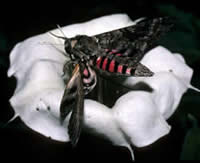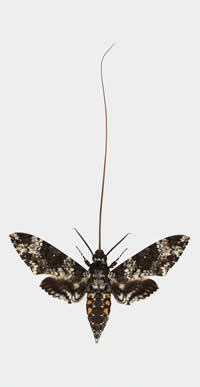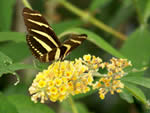USDA Forest Service Celebrating Wildflowers
|
|
|
Hawk Moths or Sphinx Moths (Sphingidae)
By Steve Buchman Moths live in a wide variety of habitats around the world. They usually go unnoticed, except when flying erratically around your porch light, a streetlight, or other source of light during the darkness of night. Perhaps you notice their handiwork when you find small holes in a woolen garment stored in your closet or you find your tomato plants consumed by a hungry tomato hornworm. Most moths work the night shift, unlike their “respectable cousins” the butterflies, which are out during the daytime, and glorified in prose, poetry, and art. Unfortunately, we usually vilify moths because of their association with the dark of night and our innate fear of darkness and things that go bump in the night. Do you remember the monsters under your bed? They get little respect, except from the relatively few scientists and naturalists who are passionate about their study and who study moths and their ways. Moths represent a biological storehouse of interesting, dramatic, and unusual behaviors, some with roles as pollinators, and others as food for other animals. All have interesting stories to tell if we will only take the time to stop, look, listen and smell the hidden world of moths and their flowers. Planting moonlight or a fragrance garden is a sure way to enjoy not only these wonderful blossoms, but also their nocturnal pollinators, especially the giant hawk moths.
Estimated populations of 11,000 moths are known to occur in the United States. Around the world, another 160,000 species of moths have been catalogued. A staggering 200,000 or more species of moths may exist, just waiting to be discovered. The number of moths far outnumbers the number of world’s species of butterflies (17,500 species). Not all moths are a drab brown or white. Many moths come clothed in a myriad of colors and patterns, some brighter than those flashy butterflies, and just as interesting. Like butterflies, minute scales cover the wings of moth, making them slippery to the touch. If you have ever held or tried to catch a butterfly or moth, the “powder” or “dust” that comes off on your fingers is their scales. Some of the largest moths in the world belong to the hawk moth or Sphingid family within the order Lepidoptera (the animal order that includes butterflies and moths). These magnificent animals have long narrow wings and thick bodies. They are fast flyers and often highly aerobatic. Many species can hover in place. Some can briefly fly backwards or dart away. Hawk moths are experts at finding sweet-smelling flowers after dark. They are especially fond of Datura (Jimpson weeds), Mirabilis (Four O’clocks), and Peniocereus (Queen-of-the-night cactus) blossoms. These flowers are highly fragrant with long floral tubes concealing pools of thin but abundant nectar.
Hawk moths have the world’s longest tongues of any other moth or butterfly (some up to 14 inches long). Charles Darwin knew of the star orchids (Angraecum spp.) from Madagascar that had nectar spurs over a foot in length. Darwin was ridiculed by other scientists of his day for predicting that these orchids would be pollinated by hawk moths. After his death, hawk moths with tongues long enough to sip of the nectar produced by the star orchids were discovered on the island of Madagascar. The caterpillars (larvae) of hawk moths are the familiar green hornworms or tobacco worms, familiar to gardeners who plant tomatoes. Since some hawk moths are minor crop pests, aerial application of pesticides to protect crops sometimes affects their numbers. With the populations of all the sphinx moths affected by this agricultural practice there are fewer sphinx moths that pollinate rare plants, like the famous Queen-of-the-night cactus or the sacred Datura, which live in northern Mexico and along the border in the desert southwest. Moths pick up pollen on their legs and wings when they visit flowers and deposit pollen (accidentally) on subsequent floral visits. Two kinds of small moths (Yucca moths and the Senita cactus moth) actually pick up pollen and jam a pollen ball onto the stigmas of their flowers in order to assure food, the resulting immature seeds, for their caterpillars. They are some of the only insects to pollinate flowers “purposefully”. For Additional Information
|
|
| NOTE: PDF format links require the Adobe Acrobat Reader to view. | |
| top | Disclaimers | FOIA | Privacy Policy | Quality of Information | Photo Credits & Use |
Location: http://www.fs.fed.us/wildflowers/pollinators/pollinator-of-the-month/hawk_moths.shtml
Last modified: Tuesday, 20-May-2008 15:55:58 EDT
